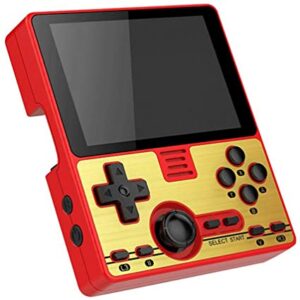| Powkiddy RGB20 Price: $85 Find it on: eBay, Amazon, AliExpress  |
Rating: 6.5/10
Pros: Cons: |
Anyone who has been following the retro handheld scene in the last year or so is familiar with the RK3326. The chip first started appearing in handhelds based out of China in spring 2020, and is the go-to chip for the ODROID GO Super, the Anbernic RG351 series, and Powkiddy’s already existing RGB10.
To be sure, the RK3326 is an upgrade over its 2019 predecessor, the JZ4770, and lifted handhelds in the $80-$100 range into a different stratosphere, with the ability to emulate everything up to N64 nearly flawlessly, with some limited Dreamcast and PSP support. But the RK3326 market has become flooded, which means that any handheld coming out this late in the game needs to outperform its already existing competition in one of the following ways in order to gain a foothold.
It must either: (1) be competitively priced to undercut the competition; (2) offer a unique, superior, or premium form factor; or (3) offer best in class screen, sound and battery life. Otherwise, what’s the motivation for someone owning an Anbernic RG351P shelling out more money to purchase Powkiddy’s new RGB20? Unfortunately, the RGB20 doesn’t outperform in any of those three categories, and only separates itself in very narrow categories that are outside the mainstream.
The RGB20 is priced around $90, which is on par or more expensive than already existing handhelds in the RK3326 range. It’s also more expensive than the Retroid Pocket 2, which offers better PSP and Dreamcast emulation. If Powkiddy really wanted to make a dent in the already saturated market, it should’ve been priced closer to the $60-70 range. This was a missed opportunity on their part.
The RGB20 form factor also leaves much to be desired. Unlike the more premium matting in its ODRIOD and Anbernic counterparts, Powkiddy used a rather cheap plastic cover and glued a metal plate on the face of the unit, far from what I’d expect from a $90 unit. The buttons follow suit, with a rather cheap, clicky material, and the shoulder buttons are curiously placed in the mid-rear of the unit, ergonomics be damned. Even if you have skinny fingers, the four shoulder buttons are not optimally placed. If you have plus-sized fingers, gameplay will be an incredibly frustrating experience.
Powkiddy’s best argument for the RGB20 is its gorgeous 3.5-inch IPS Display. It’s stunning, bright, and has some of the best viewing angles in retro handhelds. But it’s still late to the game. The RG351P, which came out mid-2020 and has a six-month head start, has the same exact specs. If I already owned a RG351P, why would I be motivated to buy a RGB20? The same goes for battery life. The 3000MAH Battery will likely last around 2-3 hours, but it’s the same battery as the RG351P. The ODROID GO Super actually has a 4000MAH battery, and also sports a 5″ TFT LCD Display for anyone looking for a larger screen. It simply doesn’t make any sense to pick up an RGB20 in light of what’s already out there.
There’s only two limited audiences who might pick the RGB20. The first type of buyer is one who is looking for a vertical form factor, though the RG351V is due out in early 2021, and aside from being the same price tag, will likely feature more of a polished, premium design that Anbernic is known for. The other type of buyer is someone in the market for the classic Nintendo Famicom red and gold color scheme. In that regard, the RGB20 stands alone, but that particular market is incredibly limited.
If you don’t fall into these categories (that should be about 95% of you), then pass on the RGB20 and pick up something from the RG351 series. Or, better yet, wait until mid-2021 when the RK3399 chipset becomes the gold standard, and can play a deeper library of Dreamcast and PSP games.